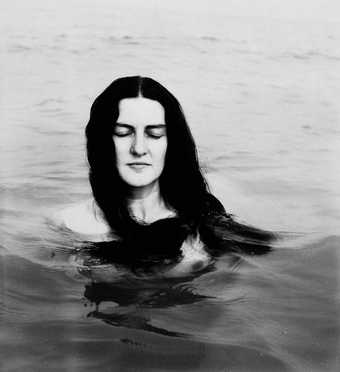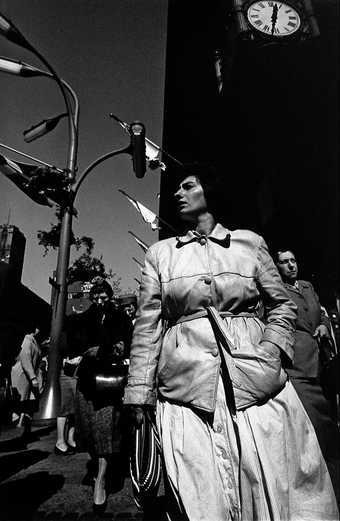
Harry Callahan
Eleanor 1949
Gelatin silver print, 124 x 111 mm
Born in Detroit in 1912, Harry Callahan describes his life before photography as being ‘nothing very spectacular’. After dropping out of an engineering degree course, he found himself working as a clerk for Chrysler, where in 1938 he joined the amateur camera club. In 1941 he attended a workshop given by Ansel Adams and decided to pursue photography seriously.
Callahan, who died in 1999, became an important teaching figure in the New Vision movement and the development of post-war American photography, first, on the invitation of ;László Moholy-Nagy, at the Institute of Design in Chicago, the post-war home of the Bauhaus, then in 1961 setting up the photography department at the Rhode Island School of Design, where he taught until his retirement in 1977. But he suggests it was his own lack of formal training that allowed him to be experimental without feeling the burden of art history. His work is a personal response to his life, encompassing what he saw, felt and experienced. Unlike many photographers of his time, he didn’t give himself conceptual or technical limitations, instead seeing his practice as a ‘lifetime project’ - a constantly evolving journey.
This can most easily be understood by grouping his work into three themes, which he described in 1975 as ‘Nature, Buildings and People’, and to which he repeatedly returned over his 60-year career. The key thread linking all three is his wife, and most photographed subject, Eleanor, who he met in 1933 and married three years later. She appears nude, clothed, in close-up, in silhouette, with their daughter Barbara inside their home or outdoors dwarfed by the towering urban landscape, a lone figure in the distance on a beach or emerging from the water. These images show his dedication to the subject of the female form, but perhaps more importantly portray their relationship and the central role Eleanor had in his life (Eleanor 1949).

Harry Callahan
Chicago 1961
Gelatin silver print, 191 x 241 mm
Although diverse in subject matter and approach, Callahan’s œuvre demonstrates a sustained interest in line and composition, depth of field, multiple exposures and the relationship between his chosen medium and abstraction. The last of these can be seen particularly in his images of nature. Disregarding the limits of conventional spectacular landscapes (as portrayed by Ansel Adams), he gives equal focus to both broad perspectives and individual organisms in his many studies of grass, foliage and weeds in snow. In Weed Against Sky, Detroit 1948, the organic form when photographed against a clear sky could be mistaken for an abstract drawing.
Callahan would spend most mornings out shooting and inevitably photographed the cities in which he lived. His interest in line and composition features strongly in his cityscapes, be it the towering buildings of Chicago or the wooden houses in Providence, or when looking at the metropolis in more detail, with close- up images of shop windows or the abstractions of paper peeling off walls, creating a jigsaw of block colours in Chicago (Abstraction) 1951. He also turned the camera on the inhabitants, making several series of people in the streets taken from low angles, often surreptitiously as Callahan was unusually shy (Chicago 1961).
Despite the variety, there is a certain still quality which runs through all of Callahan’s work. Landscapes and portraits sit seamlessly side by side, sometimes even overlapping, for example when taken as multiple exposures, a technique he often experimented with (Eleanor,Chicago c.1949). And his colour images fit comfortably within his overall practice, perhaps because he began experimenting with colour as early as 1941 (due to the technical limitations of the medium at the time and the expense associated with making durable dye transfer prints, he didn’t print or exhibit them until the mid-1970s).
The collection at Tate is representative of Callahan’s long career, including black-and-white works he printed in the 1960s and 1970s, colour dye transfers from the 1980s and large black-and-white prints on aluminium made under his supervision in the 1990s. This mix of periods and subject matter makes for an exciting introduction into his world, where ‘creativity can only be measured by the value of an individual’s whole photographic life from beginning to end’.
